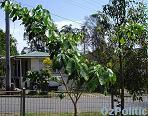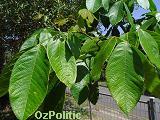|
Inga Bean
Previous
Next
Up
Home
Inga edulis, aka ice cream bean

A few years back I made a trip up north, past Cairns. I came back with a heap of seedlings from interesting tropical fruit trees. A few samples of each survived and I started planting them out recently. The Inga is the only one that has thrived. It hasn't starting fruiting yet, but when they do they put out large pods containing a row of seeds. Each seed is coated in a white cotton-like layer that tastes like vanilla ice cream. They are ready to pick when the pods bulge outwards in the centre.
 These trees are nitrogen fixing. They grow quickly and get very large, making good shade trees. They are similar to Chinese Elm in many respects and are even considered a pest along some northern NSW rivers. They are an ornamental tree and have large leaves that make it appear lush even when other plants appear dry. Permaculture enthusiasts use them for an 'upper canopy'. They are native to South America and are planted there on a rotational basis with other crops, as they return soil fertility after slashing and burning.
These trees are nitrogen fixing. They grow quickly and get very large, making good shade trees. They are similar to Chinese Elm in many respects and are even considered a pest along some northern NSW rivers. They are an ornamental tree and have large leaves that make it appear lush even when other plants appear dry. Permaculture enthusiasts use them for an 'upper canopy'. They are native to South America and are planted there on a rotational basis with other crops, as they return soil fertility after slashing and burning.
Inga is a genus of tropical trees and shrubs, member of the infrafamily Ingeae. Inga's leaves are pinnate, and flowers generally white. Many of the hundreds of species are used ornamentally.
Inga species, most notably Inga edulis (commonly known as "Ice Cream Bean") will often have edible fruit. The name derives from the fact that I. edulis resembles vanilla ice cream in flavour.
Crop rotation techniques using species of Inga such as I. Edulis ("ice-cream bean"), or known as "ice cream", have been developed to restore soil fertility, and thereby stem the tide of continual slashing and burning of the rainforest.
|